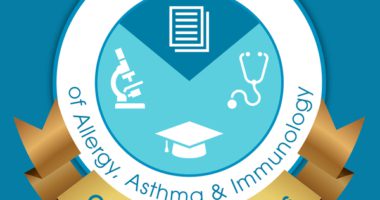 Happy March to all! It looks like the end of winter is in sight for most of our country. We are all beginning to see a warming trend coming. It is this time of year that news media, patients’ and providers’ thoughts turn to allergy. While pollen may be a big part of the discussion, many are turning their attention to factors that may influence whether – and how much – they may suffer from allergies this season. A recent emphasis that has an ancient history has captured the attention of many patients, providers and the public and is the emphasis of this month’s Annals issue – the microbiome. We have some very interesting papers that I believe you will find engaging, informative and useful in your patient care efforts.
Happy March to all! It looks like the end of winter is in sight for most of our country. We are all beginning to see a warming trend coming. It is this time of year that news media, patients’ and providers’ thoughts turn to allergy. While pollen may be a big part of the discussion, many are turning their attention to factors that may influence whether – and how much – they may suffer from allergies this season. A recent emphasis that has an ancient history has captured the attention of many patients, providers and the public and is the emphasis of this month’s Annals issue – the microbiome. We have some very interesting papers that I believe you will find engaging, informative and useful in your patient care efforts.
To begin, I highly recommend you read two Perspectives articles that will provide a good background for other features. The first, by Donald Leung, MD, FACAAI, from Denver, who begins by reminding us of the relationship between pathogenic microorganisms and allergic diseases from severity to development. Using atopic dermatitis as an example, he explains how the natural microbial content of the skin (the microbiome) is necessary as part of the host protective mechanisms and how that, when interrupted by different agents such as overuse of antibiotics, can interrupt the microbial diversity of the skin resulting in epithelial damage/dysfunction. He goes on to describe several other allergic diseases affected by disturbance of the microbiome including airway and gut. His article provides the perfect background to orient the reader to the various aspects of the microbiome as it relates to other allergic diseases.
The other perspective is by Christina Ciaccio, MD, FACAAI, from Chicago, who addresses the potential for modulating the microbiome as a therapeutic option for various allergic diseases. This provocative article leads the reader on a brief journey through the seminal work that has been published on the positive disease impact that can result from the use of various agents affecting the microbiome, including prebiotics, probiotics and postbiotics, for treatment of allergic diseases. She further posits that this approach has the potential to significantly affect future therapeutic considerations and even prophylactic strategies in at risk individuals.
Continuing the emphasis for this month, Teruaki Nakatsuji. PhD and Richard Gallo, MD from University of California at San Diego provide an outstanding CME review on the role of the skin microbiome in atopic dermatitis (AD). They remind us that patients with AD have a dysbiosis of the skin microbiome resulting in a dominance of Staphylococcus aureus on the skin associated with increased AD activity. The dysregulated Th2 network in AD skin suppress epithelial production of antimicrobial peptides (AMPs) that allow the S. aureus pathogen to flourish. There is a relative deficiency of coagulase negative staphylococcal species which further contribute to the lack of AMPs in the skin. They close by suggesting that microbiome replacement may have significant therapeutic potential by controlling skin colonization with S. aureus which will be most useful for AD patients.
I hope this little mini tour has whetted your appetite to read these and other interesting articles in this month’s Annals. Remember we welcome your comments about these and other articles and would be happy to receive written comments at annallergy@umc.edu.
Gailen D. Marshall, Jr., MD PhD FACAAI
Editor-in-chief
